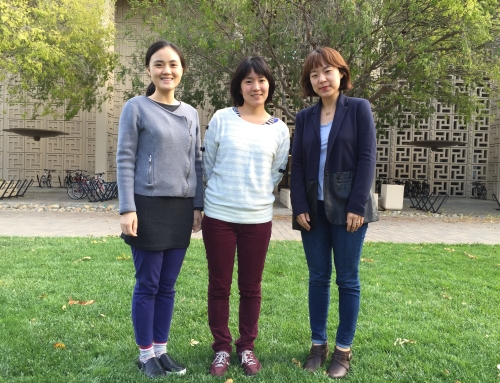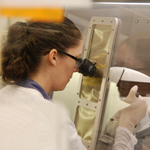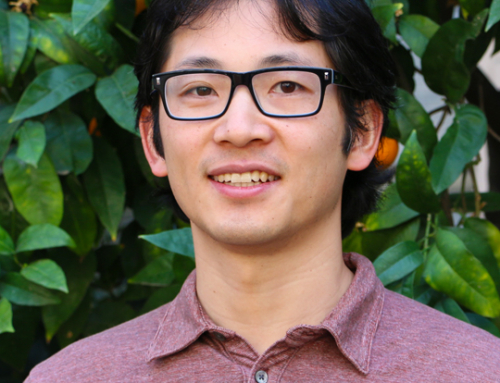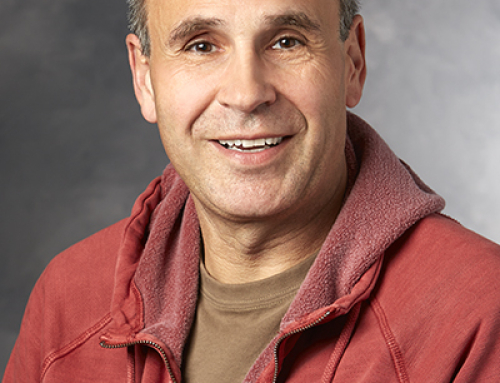
by Sara Talaei, Postdoctoral Research Fellow in the Ricci Lab
Experiencing a deep, pure joy in learning and exploring various fields of science has been one of the greatest gifts of the universe to me. Working on a research topic is like stepping into a magical world where there is only creativity and the glory of new understandings. Time stops in that world, and nothing else matters. In fact, it is hard to imagine myself not being engaged with research at any point in my life. Laboratory is my favorite sanctuary.
I was born in Iran, and started my academic studies with biomedical engineering and bioelectrics in Tehran. At that time, I realized that miniaturization and the science of fabricating sensors with high accuracy is going to evolve the field of biomedicine. So, I decided to go to Europe, and learn about the new emerging field of micro and nanotechnology. In 2007, I moved to Switzerland which is well-known for its long history in miniaturization and precision mechanics. After receiving my masters in this field, I continued with a PhD in BioMEMS (Bio Micro Electro Mechanical Systems), and developed my microengineering skills for biomedical applications by designing biosensors and microfluidic cell cultures. I was privileged to work in the group of Prof. Nico de Rooij who is an outstanding professor in the field of microengineering managing one of the most experienced laboratories at EPFL (Ecole Polytechnique Federale de Lausanne) with a great know-how in design and microfabrication of sensors and actuators. In the middle of my PhD, I became interested in neuroscience and how microengineering can be helpful in this branch of science. So, with Nico’s support, I started a project with my neuroscientist friends in Italy in the laboratory of Dr. Luca Berdondini at the Italian Institute of Technology. That experience made me even more enthusiastic about shifting my career towards neuroengineering, and I realized my next step is to enhance my knowledge in neuroscience.
To me there is no boundary for exploring new fields of science. I enjoy embracing my boldness and traveling around the world, looking for resources and people that can teach me what resonates with my curiosity. There is of course a certain amount of failure attached to that when you go outside of your comfort zone, and try something new. But I believe, the more you learn in various fields, the more creative you can be for solving a scientific problem.
So, after finishing my doctoral studies in Switzerland, I looked around to find a great teacher who could train me in neuroscience. I was introduced to Prof. Anthony Ricci as a brilliant knowledgeable professor who is excellent in his research, and enjoys teaching his craft. In our first Skype conversation, Tony was so open and friendly that I immediately felt I had contacted the right person I had been looking for as my mentor. I talked to him about my engineering background, and how much I am willing to explore biology and neuroscience. He kindly ensured me that he will teach me as long as I keep interest in learning. He also explained how he supports diversity in academia, and encourages having people with different scientific, cultural and personal backgrounds in his group. To me, this vision of Tony was an additional reason that made me interested in joining his group. So, in May 2015, I moved to the USA to learn from Prof. Ricci and work in his laboratory at Stanford.
In Ricci lab, we are trying to understand how the auditory cells (i.e. inner hair cells and outer hair cells) communicate with the brain. It is now known that the main part of auditory information is sent to the brain via the signals formed at the synapses between the inner hair cells and spiral ganglion neural fibers. We know that these signals are modulated by glutamate which is a principal excitatory neurotransmitter. Glutamate is released by the hair cells as a result of depolarization of the cells in response to a sound. Following the release of glutamate in the synaptic region, an electrical signal is generated in the neural fiber that travels to the brain. Therefore, our hearing depends on the exchange of chemical and electrical signals that occurs in inner hair cells and the neural fibers that form synapses with them. Each inner hair cell is innervated with 10-15 neural fibers. Yet, it is not clear under which circumstances each neural fiber is fired: are they all fired simultaneously, or each fiber has a specific threshold, and is responsible for sending a different type of information. Outer hair cells are also forming glutamate synapses. But there are less neural fibers synapsing with them. What kind of information are the outer hair cells responsible for to be communicated with the brain?
If we could monitor the exchange of chemical and electrical signals in the inner ear in response to sound stimulations, we could find answers for all these questions. However, the challenge is that having access to the synaptic region of inner hair cells in-vivo is so complex, and the exchange of these signals is so fast that with the current technology nobody could have performed such experiment. In Ricci lab we are pushing through the limitations, and trying to develop application of genetically encoded indicators in the hair cells and spiral ganglion neural fibers. This will enable us monitoring the release of glutamate from the hair cells and the fluctuations in their electrical potential and the innervating neural fibers upon sound stimulations.






Leave A Comment